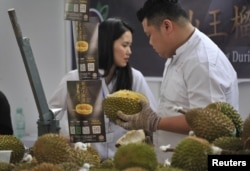As China's first homegrown durian crop heads to consumers later this month, exporters in Vietnam remain confident the initial yield from Hainan Island will not meet the seemingly insatiable Chinese demand for the famously stinky fruit.
In March, Chinese officials said they anticipated a 2,450 metric ton Chinese durian crop this year, according to official broadcaster China Central Television (CCTV). But Feng Xuejie, director of the Institute of Tropical Fruit Trees at the Hainan Academy of Agricultural Sciences, told CCTV that Hainan will produce about 50 metric tons of durian this year. That would account for only 0.005% of the 1 million metric tons eaten in China this year, according to the South China Morning Post.
"For sure, Hainan cannot produce enough durians to feed the population of 1.4 billion people," Vo Tong Xuan, an agronomy professor at Vietnam's Nam Can Tho University, where he is also president, told VOA Vietnamese by phone.
In September 2022, Vietnam exported its first fresh durian to China after four years of negotiations, making it the second country, after Thailand, with official access to the huge Chinese durian market. According to data from the General Department of Vietnam Customs reported by the local Nhan Dan Daily, durian sales are expected to top $1 billion in the Chinese market by the end of 2023. Like all media outlets in Vietnam, Nhan Dan Daily is controlled by the government.
Durians are China's most valuable fresh fruit import, valued at $4.21 billion in 2021, mostly from Thailand.
But the value of the fresh durian Vietnam exports to China has grown faster than the fruit's stench can permeate a shopping mall, topping more than $190 million in the first four months of 2023 — durian's off-season — or almost six times more than the same period last year, according to the website, VN Express, citing data from Vietnamese Ministry of Industry and Trade's Import-Export Department.
In May, the value of durian exports skyrocketed to $332 million, or a year-on-year increase of 18 times, for a total of $503.4 million for the first five months of 2023, according to ministry figures cited by VN Express.
'Not viable'
Vietnamese durian growers appear to be confident they will survive even if China can now grow its own.
Although Hainan Island enjoys a climate suitable for durian cultivation, "Hainan soil is not as rich in alluvial sediment, which is good for durian, as the Mekong Delta, thus affecting the taste of durians," Huynh Tan Loc, director of the Ngu Hiep Cooperative Farm, told VOA Vietnamese in a telephone interview.
Even if China does increase its durian crop, Vietnamese growers will continue to make a profit on their fruit, according to Xuan of Nam Can Tho University.
After peaking at $8.4 per kilo in February when Chinese importers rushed to secure their shares since Thai durians were not in season, in early June durians can be found selling in Ho Chi Minh City street stalls for $2.5 per kilo, as observed by VOA Vietnamese. Xuan said growing durian costs $1.25 per kilo.
Doan Nguyen Duc is chairman of Hoang Anh Gia Lai Corporation, which cultivates 1,000 hectares of durian in Vietnam and Laos. At a shareholder meeting earlier this month, he said Vietnam's durian growers "never suffer losses," according to Vietnamese press accounts.
Duc said that "demand still outstrips supply" in China.
In Cai Be District, Tien Giang Province, the biggest durian growing district in the Mekong Delta, durian grower Loc said he worries about "uncontrolled mass production" as farmers switch from their usual crops to grow durian.
In February, the Ministry of Agriculture and Rural Development's Department of Crop Production warned of oversupply, according to press accounts. According to the department, by the end of 2022, farmers had 110,000 ha durian cultivation, exceeding the government's plan by 35,000 ha, according to press reports. One ha is about 2.5 acres.
Officials project the 2023 durian crop will be 1 million metric tons in 2023, an increase from more than 640,000 in 2021, according to Vietnam Agriculture.
Other markets
Some Vietnamese durian exporters are looking beyond the Chinese market. Loc, who ships two, 18-metric-ton containers of fresh durian to China by land per day, has invested in cold storage facilities and exports 16 metric tons of frozen durian to Japan each month by air.
"The Japanese market is steadier, while in China, price can go up dramatically, but then plummet rapidly," Loc remarked.
Thai Tran, managing director of London-based TT Meridian, told VOA Vietnamese in a telephone interview that "fresh Vietnamese durians are selling so well" in the U.K. that he cannot meet demand even at $12.75 to $16.60 per kilo.
The trading company imports on average 3 to 5 metric tons of fresh durian from Vietnam by air every week and could sell 10-20 tons a week if the U.K. lifted import controls, he said.
While the U.K. is not "an alternative to the Chinese market," it helps Vietnamese farmers reduce reliance on it, he said, adding that as more consumers in the U.K. try durian, they're finding it's "an addictive fruit. Once you overcome [an] initial aversion, once you try it, you'll fall for it."
Adrianna Zhang of VOA Mandarin contributed to this report.









